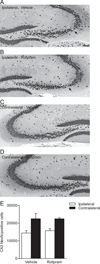Effects of early rolipram treatment on histopathological outcome after controlled cortical impact injury in mice
- PMID: 23103712
- PMCID: PMC3527646
- DOI: 10.1016/j.neulet.2012.10.019
Effects of early rolipram treatment on histopathological outcome after controlled cortical impact injury in mice
Abstract
Traumatic brain injury (TBI) pathology includes contusions, cavitation, cell death, all of which can be exacerbated by inflammation. We hypothesized that an anti-inflammatory drug, rolipram, may reduce pathology after TBI, since in several CNS injury models rolipram reduces inflammation and improves cell survival and functional recovery. Adult male C57BL/6 mice received a craniotomy over the right parietotemporal cortex. Vertically directed controlled cortical impact (CCI) injury was delivered. Naïve controls were used for comparison. At 30 min post-surgery, animals were treated with vehicle or rolipram (1 mg/kg), and then once per day for 3 days. On day 3, the brains were systematically sectioned and stained to visualize the resulting pathology using hematoxylin and eosin (H&E) staining and NeuN immunocytochemistry. Total parietotemporal cortical contusion and cavity volume were significantly increased in rolipram-treated as compared to vehicle-treated CCI animals. Contusion areas at specific bregma levels indicated a significant effect of drug across bregma levels. Neuronal cell loss in the dentate hilus and area CA3 of the hippocampus were similar between vehicle and rolipram-treated animals. Although rolipram is well known to reduce pathology and inflammation in several other CNS injury models, the pathology resulting from CCI was worsened with rolipram at this particular dose and administration schedule. These studies suggest that consideration of the unique characteristics of TBI pathology is important in the extrapolation of promising therapeutic interventions from other CNS injury models.
Copyright © 2012 Elsevier Ireland Ltd. All rights reserved.
Figures



References
-
- Ariga M, Neitzert B, Nakae S, Mottin G, Bertrand C, Pruniaux MP, Jin SL, Conti M. Nonredundant function of phosphodiesterases 4D and 4B in neutrophil recruitment to the site of inflammation. J. Immunol. 2004;173:7531–7538. - PubMed
-
- Block F, Tondar A, Schmidt W, Schwarz M. Delayed treatment with rolipram protects against neuronal damage following global ischemia in rats. Neuroreport. 1997;8:3829–3832. - PubMed
-
- Chang YC, Huang CC, Hung PL, Huang HM. Rolipram, a phosphodiesterase type IV inhibitor, exacerbates periventricular white matter lesions in rat pups. Pediatr. Res. 2008;64:234–239. - PubMed
Publication types
MeSH terms
Substances
Grants and funding
LinkOut - more resources
Full Text Sources
Other Literature Sources
Miscellaneous

